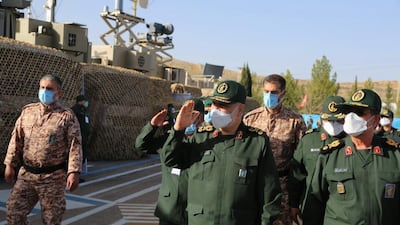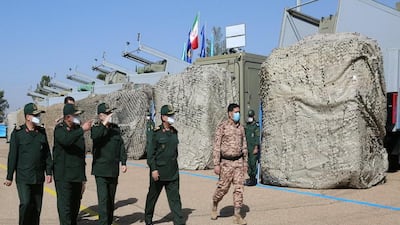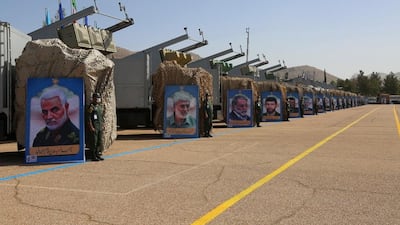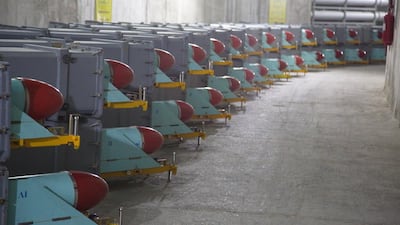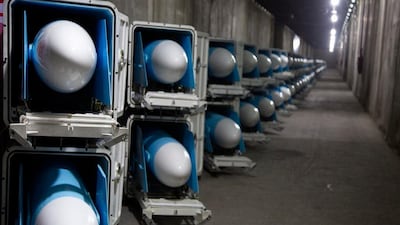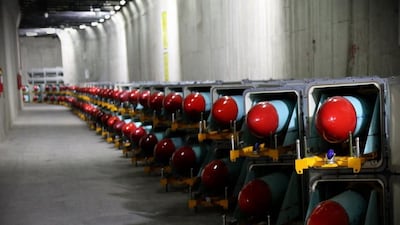Iran has revealed a second vast underground missile base capable of what it calls "remote warfare".
Experts say the video footage broadcast on Iranian state TV will probably increase concerns in the region and the West about Tehran's missile programmes. This could make diplomatic talks around a return to the 2015 nuclear deal more difficult.
Iran's Islamic Revolutionary Guard Corps on Monday described the new base as a subterranean "missile city", the state news agency Tasnim reported.
In addition to its collection of ballistic and cruise missiles, the new facility "can launch mines in various ranges" and is equipped with remote warfare capabilities, the Revolutionary Guard said.
The term "remote warfare" suggests the base houses drones.
Norman Ricklefs, a former adviser to the US and Australian militaries in Iraq, said the display was a "calculated warning" by Iran's armed forces.
Although Iran's president and other political figures say the US must take the first steps towards returning to the nuclear deal, experts say Iranian hardliners are not interested in making an agreement.
"Those who put this film together must know that it will only further heighten fears about Iran in most Western capitals and therefore make a quick return to the nuclear deal even more difficult for the Biden administration," Mr Ricklefs said.
"That raises the likelihood that this kind of aggressive messaging is meant to undermine America’s ability to return to the nuclear deal. Thus, the possibility that Iran does not want to return to the 2015 nuclear deal is something that should be taken seriously."
Although Mr Ricklefs said there was a possibility “those who produced the film and publicised it didn’t understand its impact in Western countries”, that was probably not the case because it would “suggest a lack of sophistication that seems unlikely”.
The latest missile city revelation comes after images of a similar base were released in January.
The January video showed IRGC head Gen Hossein Salami touring long, cavernous tunnels large enough for convoys of 10-wheel trucks carrying ballistic missiles to drive through – something also shown in the footage.
Why is Iran building underground bases?
Iran is increasingly moving its nuclear facilities and large ballistic missile arsenal underground.
The aim is to make critical missiles and launch sites harder to hit from the air in any potential conflict.
A potential adversary would need large numbers of "bunker buster" bombs and dangerous flights over Iranian territory to disable the deep, reinforced bunkers.
These missiles and bombs capable of hitting buried targets, with names such as the Massive Ordnance Penetrator and the Mother of All Bombs , are in the US Air Force's inventory in limited numbers.
To date, only the US has an air force with this capability, although Israel has a number of smaller, similar bombs called GBU-28s.
The MOAB and the MOP are between 10 and 20 times more powerful than the bombs typically used for precision strikes on large targets, such as bunkers housing soldiers.
When former US president Donald Trump ordered the US Air Force to drop a MOAB on a Taliban cave complex in 2017, Pope Francis expressed his outrage at the name of the device.
"A mother gives life and this one gives death, and we call this device a mother. What is going on?" the pontiff asked.
The MOP is designed to penetrate the ground before exploding, causing shockwaves through the earth to crush underground structures like those featured in the video.
Hezbollah – Iran's proxies in Lebanon – and the Houthis in Yemen have also made extensive use of underground caves and tunnels to minimise the threat from enemy airpower.
Back to the nuclear deal?
In 2018, Mr Trump pulled out of the Obama-era Joint Comprehensive Plan of Action – the Iran nuclear deal – claiming that Tehran was not complying with the agreement.
New sanctions on Iran's economy led to a 12 per cent economic contraction and an 80 per cent reduction in Iranian oil exports.
As the Biden administration signals a thawing of relations with Iran and a possible return to the nuclear deal – where Iran's nuclear programme would be limited and subject to inspections – Mr Biden will have to re-assure sceptics in Congress and Gulf allies, who are concerned not only about Iran's nuclear programme but also its large conventional weapons programme.
Revealing the extent of Iran's missile arsenal in high-profile state TV broadcasts is likely to complicate an already delicate situation with the EU and the UK, which support a return to the nuclear deal but are also concerned about Iran's conventional weapons.
